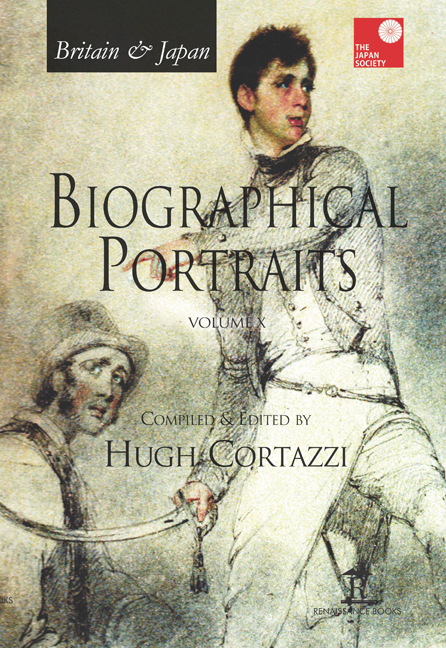Book contents
- Frontmatter
- Dedication
- Contents
- Introduction
- List of Contributors
- Index of Biographical Portraits in Japan Society Volumes
- PART I BRITAIN IN JAPAN
- PART II JAPAN IN BRITAIN
- Select Bibliography of Works in English on Anglo-Japanese Relations [Compiled by Gill Goddard – Retired East Asian Studies Librarian, University of Sheffield]
- Select Bibliography of Works in Japanese on Anglo-Japanese Relations [Compiled by Akira Hirano, SISJAC]
- Index
48 - Minton for the Meiji Emperor
Published online by Cambridge University Press: 07 May 2022
- Frontmatter
- Dedication
- Contents
- Introduction
- List of Contributors
- Index of Biographical Portraits in Japan Society Volumes
- PART I BRITAIN IN JAPAN
- PART II JAPAN IN BRITAIN
- Select Bibliography of Works in English on Anglo-Japanese Relations [Compiled by Gill Goddard – Retired East Asian Studies Librarian, University of Sheffield]
- Select Bibliography of Works in Japanese on Anglo-Japanese Relations [Compiled by Akira Hirano, SISJAC]
- Index
Summary
INTRODUCTION
THERE ARE THREE dessert stands dating from the late nineteenth century in the collections of the Imperial Household Agency in Tokyo: a low comport with a turquoise blue border with roses in reserves and two pierced baskets — one of double-lozenge shape and supported by a pair of reclining putti bedecked with vines, the other round and carried on the heads of the Three Graces as they stand back to back. Shaped to suit the dining practices of late nineteenth-century Europe and America, with their classical imagery and rococo styling these objects may also be considered consummately ‘Western’ in style, and yet each is ornamented with the Japanese imperial chrysanthemum crest. Nonetheless, these ceramics were not crafted from Japanese porcelain, but English bone china; the marks on their bases revealing that they were created in Minton's factory at Stoke-on-Trent.
Following the Meiji Restoration, the emperor's duties came to include the reception of foreign dignitaries. In time, the emperor's role in such engagements extended to the banqueting table, and from 1873, meals in Western style became a feature of imperial receptions for the diplomatic corps. Demanding more than just people and food, these occasions also required an abundance of objects for the dinner table.
In 2000, these three Minton dessert stands were displayed as part of the exhibition ‘Kyōen: kindai no tēburu āto’ (English title: ‘Imperial Feasts: Modern table art’) at the Sannomaru Shōzōkan, the Museum of the Imperial Collections. Featuring examples of Meiji-era Western-style tableware preserved in the collections of the Imperial Cuisine Division, this exhibition offered a glimpse of the material culture of the Meiji Emperor's table. Nonetheless, much about these objects remained uncertain. Dating the dessert stands to around the 1870s to 1880s, the curator, Ōkuma Toshiyuki, questioned how these items had been acquired: were they commissions or were they a gift? Furthermore, with only three pieces extant, were they actually used? Working primarily from the objects themselves, it was only possible to conjecture. However, as a painting of a dessert plate with turquoise blue border and reserves of roses in the Minton Archive indicates (Figure 1), these objects also left traces in the archival record: traces that may be found both in Britain and Japan.
- Type
- Chapter
- Information
- Britain & Japan Biographical Portraits Vol X , pp. 542 - 553Publisher: Amsterdam University PressPrint publication year: 2016

